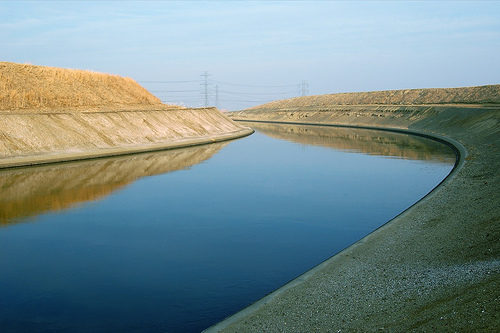As Californians, we’re all keenly aware of the “big one” that’s looming. I would imagine that most people consider the potential impacts of an earthquake in their community. So we buy earthquake kits, flashlights, bottled water, extra canned food for our homes—we take action to prepare. And I imagine that most people expect that those who manage our state’s infrastructure and other public services also take the necessary steps to prepare for a major earthquake. In many ways, California is ahead of the game. Billions of dollars have been spent to retrofit bridges, highways, hospitals, schools and prisons. But to date, no effective measures have been taken to secure our water supply in the event of an earthquake.
It’s time to retrofit our state’s water delivery system.
We’ve been repeatedly warned by leading scientists, engineers, water managers and other experts that a significant portion of the state’s water supply could be wiped out for a year or longer if a major earthquake strikes Northern California. The U.S. Geological Survey, the national expert on earthquakes, has warned that a 6.7 magnitude trembler in the Bay Area could contaminate and cut off a key drinking water supply for two out of three Californians, with impacts cascading throughout the state. We can’t prevent an earthquake, but we can be better prepared.
At the core of this issue is the Sacramento-San Joaquin River Delta, a network of rivers, streams, marshes and grasslands—one of the state’s most prized, yet most troubled, environmental resources and also the route for much of the state’s water supply. Just east of San Francisco, the Delta channels water that is delivered to 25 million people, businesses and farms throughout Northern, Central and Southern California. But that water is ushered through by 100-year old levees that are weak, poorly engineered and could collapse in the event of an earthquake. If that happens, water from the San Francisco Bay would rush into the Delta, turning freshwater into saltwater. One only need look at the aftermath of Katrina to recognize the dangers of a weak levee system and the havoc that ensued. The complete cut-off of the Delta water supply would be “catastrophic” warns the non-partisan Public Policy Institute of California. The economic toll of this seismic event could amount to $40 billion from losses in water supplies, farm production, wages and jobs, and downed utilities.
To avoid that day, public water agencies have been working with state and federal agencies, environmental organizations and other stakeholders to develop a comprehensive plan that would protect California’s water supply from this threat, protect local communities from flooding and devastation and restore the Delta’s ailing ecosystem. The plan, known as the Bay Delta Conservation Plan (BDCP), couples a new water delivery system with habitat restoration to achieve two vital goals: long-term water supply reliability for California and a healthy Delta ecosystem.
This is the earthquake kit that we desperately need to protect California’s water supply – not just here in Southern California but also in the Bay Area and the Central Valley.
New infrastructure — either a tunnel or canal — would isolate and carry a carefully managed portion of the Delta’s freshwater supply underneath or around the Delta, rather than through the fragile ecosystem and away from the weak levees. Several options are being explored now by the state’s experts. By doing this, we would restore reliability to our water supply, protect it from floods and earthquakes, improve water quality, all while restoring and protecting the Delta ecosystem.
It’s certainly a major endeavor—the BDCP is likely to be one of the largest public works projects in California history. It is thinking big but that’s a California standard – one we are proud of. Public water agencies have already agreed to provide the roughly $10 billion in funding for construction and operation of the new facility because the price of waiting is far greater than the price of this investment. It is a prudent, affordable and urgently-needed investment. Some of our largest infrastructure efforts have been kicked off during economic crises, recognizing the additional benefits to our citizens. Such a project will generate nearly 130,000 jobs during the seven-year construction period, and thousands more associated with the habitat restoration efforts.
With five years of research and planning and more than 300 public meetings already complete, the state is now close to finalizing the BDCP and beginning the environmental review process. The decisions made by state and federal agencies through the BDCP will determine whether we are prepared or unprepared for a major earthquake. It’s time now for residents throughout the Southland to get informed and understand the risks to our water supply system and the solutions presented by the BDCP.
An infrastructure project of such magnitude — basically re-plumbing our primary water delivery system — will surely require some difficult decisions and compromise between stakeholders and it is understandable for some to be wary of such a large undertaking. But we cannot let caution become negligence. The stakes are too high and the risks too great to not take advantage of this great opportunity before us. To get more information on the Delta and the proposed retrofit of our water system, check out www.socalwater.org/delta-disrupted.
Richard W. Atwater serves as the Executive Director of the Southern California Water Committee and has spent more than 35 years working in statewide water planning. Established in 1984, the Southern California Water Committee is a nonprofit, nonpartisan, public education partnership dedicated to informing Southern Californians about our water needs and our state’s water resources. Spanning Los Angeles, Orange, San Diego, San Bernardino, Imperial, Riverside, Ventura and Kern Counties, the SCWC’s members include representatives from business, local government, agriculture, water agencies, labor and the general public. Visit us at www.socalwater.org.





